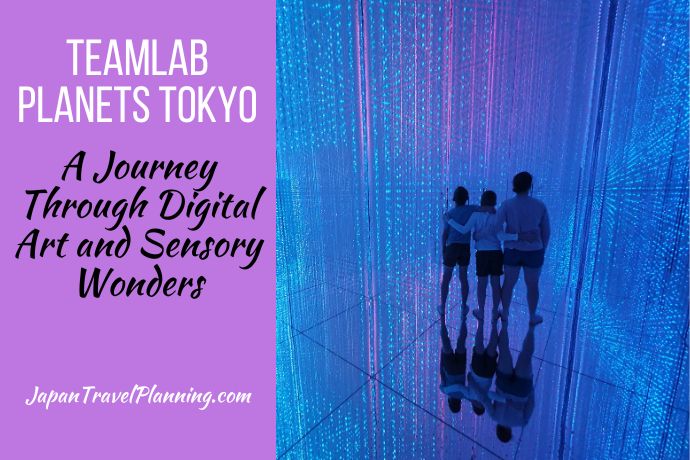The Art Aquarium Ginza is often on to-do lists in Tokyo for art and nature lovers alike. The Art Aquarium is a living art gallery featuring many different species of goldfish displayed in various elaborate tanks with vibrant colours and a soundtrack to set the atmosphere.
The Ginza Art Aquarium Museum is one of the most Instagrammable locations in Tokyo, but it also receives some polarising reviews online. Some visitors believe that the ticket price is steep. Others feel you don’t receive proper value for money for the time spent inside. Other guests have implied that there might be animal welfare issues.
After experiencing the museum for ourselves, we will touch on these issues. We’ll explain the positives and negatives. And shed light on whether the Art Aquarium Ginza is worth visiting.
Disclaimer: This article contains affiliate links. If you book after clicking on one of these links then we may receive a small commission at no extra cost to you.
- Easily purchase your Art Aquarium Ginza Ticket
- Select your preferred visiting time
- Choose the Klook Tokyo Pass to bundle your Tokyo tickets and get a great discount
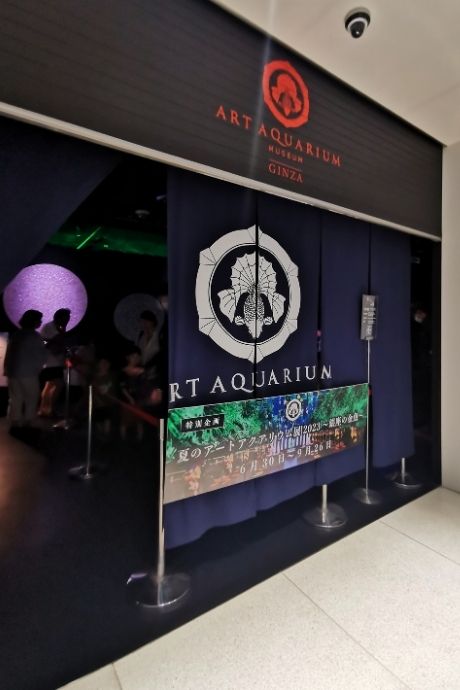
How to Get Art Aquarium Ginza Tickets
The best way to buy Art Aquarium Ginza tickets is through Klook, where they feature the best price guaranteed. With Klook, you can book your preferred date and time slot to visit the Art Aquarium.
Adult ticket prices are 2300 Yen (US$ 15.70 USD), and Child (0-12) tickets are free. For each adult, two children are permitted free entry. Children can only enter with a parent or guardian.
Klook is currently running an offer with the Adult Ticket, but it comes with a 500 Yen (US$ 3.40) discount at the Museum Gift Shop if you spend 5000 Yen (US$ 34.10). This offer is an excellent deal as it costs no extra, and the Art Aquarium Museum Shop features souvenirs that international tourists will love.
Art Aquarium Museum Tickets are also available directly through their website. The tickets are 2300 Yen (US$15.70). Again, you can choose your dedicated day and time slot entry.
Their direct website also had a Palet D’or collaboration ticket for 3000 Yen (US$20.50). This offer is a standard adult admission ticket, but it comes with a set of take-out chocolate soft-serve ice cream that you pick up at Chocolatier Palais D’or Ginza.
There are currently no discounts for seniors or family bundle tickets.
On weekends and holidays, it can become rather busy. If you buy on the day, you might not receive the exact time slot you hoped for.
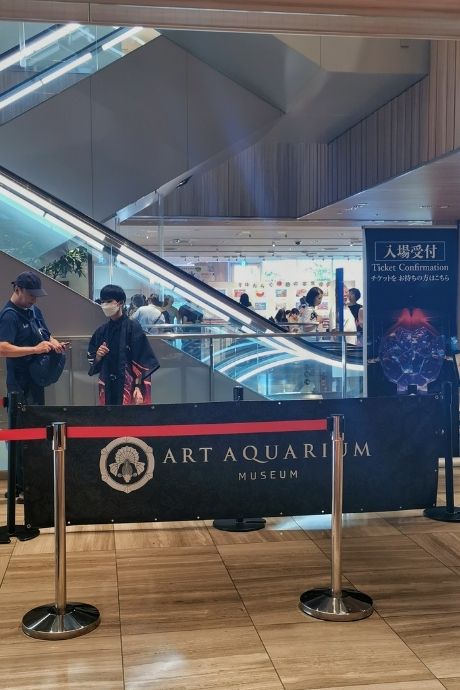
Where is Art Aquarium Ginza and How to Get There
The Art Aquarium Museum is in Ginza. Ginza is Tokyo’s most famous upmarket shopping, dining, and entertainment district. It’s a central western Tokyo neighbourhood and part of the Chuo Ward. It is located a 900m walk south from Tokyo Station.
Address
The Art Aquarium Museum Address is:
Ginza Mitsukoshi Shinkan 8F, 4-chome-6-16
Ginza, Chuo-ku, Tokyo, 104-8212
Telephone Number: 03-3528-6721
How to Get There by Train
The easiest way to access the Art Aquarium Museum Ginza is by train.
The Tokyo Metro Ginza Line, Marunouchi Line, and Hibiya Line will take you to Ginza Station. From Ginza Station, take exit A7. This exit takes you to the entrance of the Mitsukoshi Department store.
The Tokyo Metro Yurakucho Line will take you to Ginza-itchome Station. Take Exit 9, and the aquarium will be a 5-minute walk.
The Toei Asakusa Line and Tokyo Metro Hibiya Line takes you to Higashi Ginza Station. You can walk via the underground passage toward Ginza Station, which will take 2 minutes.
The JR Line will take you to Yurakucho Station. It is a 9-minute walk from the Central Exit and Ginza Exit.
How to Get There by Car
If you are travelling by car, Ginza Mitsukoshi has parking available. The parking lot is on the 4th Basement Floor. Customers who enter the museum will be given a service ticket for 1 hour free. The parking service ticket is available at the Art Aquarium Museum Shop.
Purchasing at the Museum Shop will also give you a service ticket depending on the amount spent. Spending 2000 Yen (US$13.70) or more will get you 1 hour free. 5000 Yen (US$34.15) or more will give you 2 hours free, and 30,000 Yen (US$204.90) will provide you with 4 hours free.
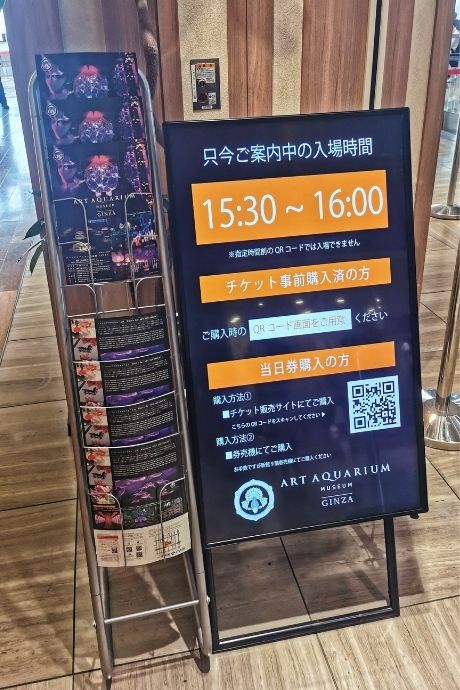
Art Aquarium Ginza Hours of Operation
The Ginza Aquarium Museum is open seven days a week with the same operation hours daily. Opening hours are 10 am – 7 pm daily.
The museum can become very crowded on weekends. If you want to explore the exhibitions and take plenty of photos along the way, visiting on a weekday morning is advisable.
Brief History of Art Aquarium Ginza
Goldfish were introduced to Japan in 1502 by China. For an extended period, goldfish were a luxury fish only kept by feudal lords and the wealthy.
Goldfish were considered to be very lucky animals. The golden colour of the fish was said to signify wealth accumulation. The red colour was thought to ward off evil.
In the 18th century, Japan experienced a goldfish boom, and many people came to keep them as pets. During this period, people admired goldfish from above and studied the patterns on their backs and tail fins. After glass tanks became popular, people started admiring goldfish from the side.
The Art Aquarium Ginza was created by and managed by artist Hidetomo Kumura. He aimed to create a place where people can admire “Kingyo” goldfish as living art.
The Art Aquarium was made as a collaboration between art, aquarium, design, and entertainment. The Art Aquarium started as a temporary exhibition in 2007 at the Mori Arts Center Gallery in Tokyo for two months.
Since then, the Art Aquarium has had many different homes across Japan. It was based at Nijo-jo Castle in Kyoto and the 21st Century Museum of Contemporary Art in Kanazawa.
The Art Aquarium even toured the world with exhibitions in Milan in 2015 and Shanghai in 2018.
Art Aquarium Tokyo opened on August 28 2020, in Nihonbashi, where it had a brief run. Then, it relocated and opened its doors to its permanent location in May 2022 at the Ginza Mitsukoshi building.
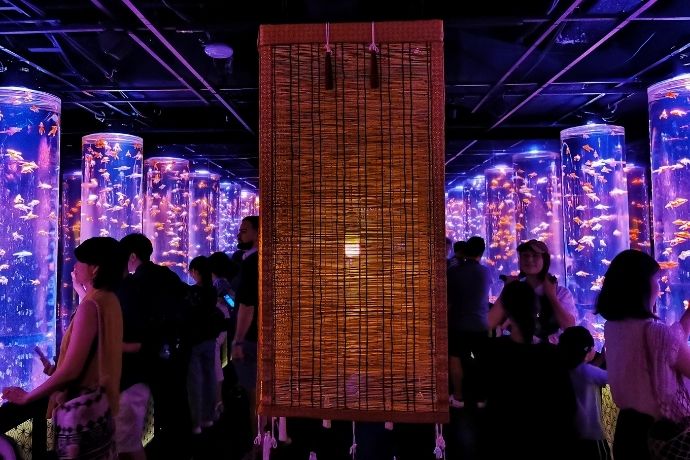
What to Expect at Art Aquarium Ginza
Although the Art Aquarium Museum Ginza has the word ‘museum’ in its name, this is not a museum in the traditional sense. The Art Aquarium Ginza is an exhibition that celebrates Japanese history and culture through living art.
The Art Aquarium Ginza focuses on Japanese goldfish. 30,000 fish are on display featuring various Japanese species, including Wakin, Jikin, Tetsugyo, and Tokai Nishiki.
Approximately 70 goldfish species are at the museum, and 30 are Japanese national breeds. These species have different colours, patterns, and shapes and can be admired from different perspectives.
Different exhibition areas display the fish with varying styles of tanks, artistic displays, and lighting effects. The Art Aquarium Ginza stays faithful to Japanese tradition while combining it with modern art and technology.
The “Goldfish Corridor” is an area that pays tribute to the corridors of Japanese temples. This room is lined with column tanks filled with goldfish. They use cleverly placed mirrors that make them appear to go from the floor to the ceiling.
“Goldfish Waterfall” is an exhibition that is inspired by a waterfall. The tanks are in a line with water flowing from the top, resembling a waterfall. These curved tanks and the changing lights shining through them create a beautiful wavy effect.
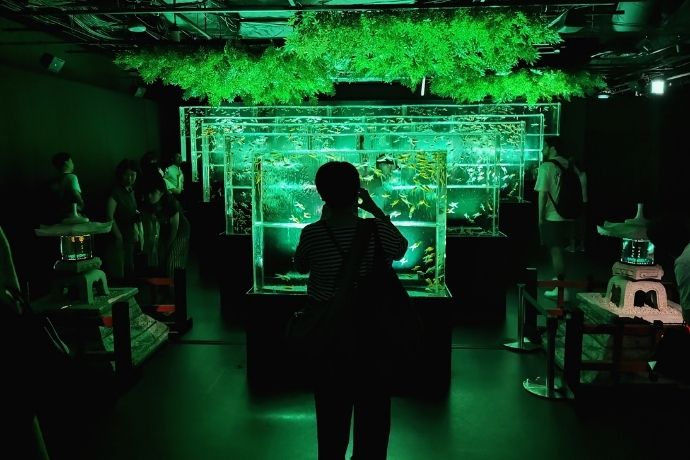
The exhibition that most resembles an art gallery is the “Goldfish Collection.” This area resembles an art gallery that you walk through. Each tank features a different rare breed of goldfish, with the name displayed below.
Some say that goldfish should be admired from the top, and the “New Goldfish Review” uses this idea. This area is filled with 24 square tanks sitting at waist height. This tank style allows you to look at the goldfish from above with no obstruction.
One of the most beautiful areas is the “Bamboo Grove of Goldfish.” This exhibition features column tanks, some with fish and others with light bubbles. These tank lights change colour to create unique colour patterns. The tanks look best when lit green, as they resemble a bamboo forest.
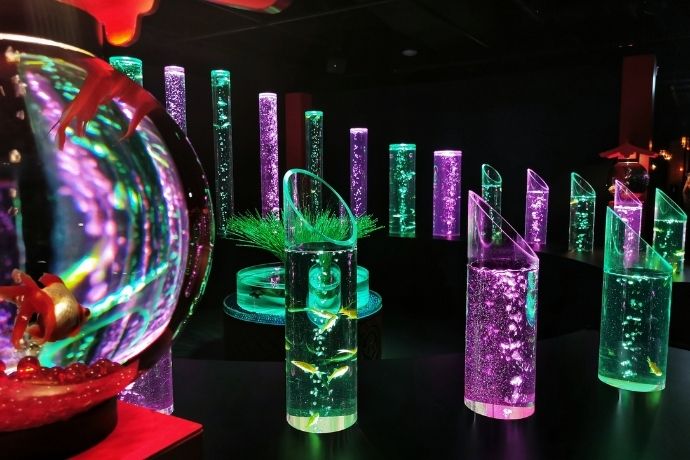
The Art Aquarium Ginza also features collaboration work with other artists. Currently, they have the “Flowerium” created by Shogo Kariyazaki, a celebrated flower arrangement artist. This area combines the Japanese art of ikebana and goldfish in perfect harmony.
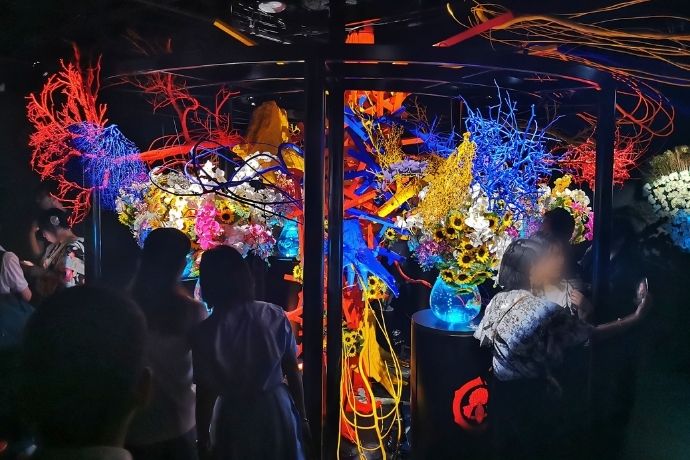
For visitors who appreciate more traditional art, there is an exhibition of Ukiyo-e art from Utagawa Kuniyoshi. More than 20 art pieces are on display depicting goldish from the end of the Edo Period.
Walking around the Art Aquarium Museum Ginza takes 30 minutes to 1 hour for most visitors. But, there are plenty of photo opportunities along the way, which could take the visiting time to 2 hours.
Photography and videos are encouraged throughout the museum, but flash photography is forbidden to not startle the fish. The Art Aquarium Ginza advises using the tanks’ lights to help light your photos.
There are also special “Photo Spots” throughout the museum. These are highlighted with a photo spot mark. You can use the spotlight to illuminate the person and take a photo in collaboration with the work.
Animal Welfare at Art Aquarium Museum
As someone who isn’t an expert on caring for fish, I will only point out some observations and share my opinion.
The Art Aquarium Museum Ginza has received a higher number of divided reviews compared to many other attractions. Visitors seem to have strongly positive or highly negative reviews.
The positive reviews come from people praising the stunning displays, Japanese culture, and the gorgeous fish. However, there are also negative reviews, with most expressing animal welfare concerns with complaints of overcrowding and small spaces.
The Art Aquarium Ginza offers an interesting blend of art and aquatic life. However, addressing the discussions surrounding animal welfare concerns that regular visitors and animal rights advocates have raised is essential.
Before you enter the aquarium, signs outside remind visitors not to tap on or touch the glass and not to use flash photography. This could disturb and startle the fish, so it’s great that they have these rules in place. I never noticed anyone breaking these rules. However, I wondered if the tanks’ bright light effects could be stressful for the fish.
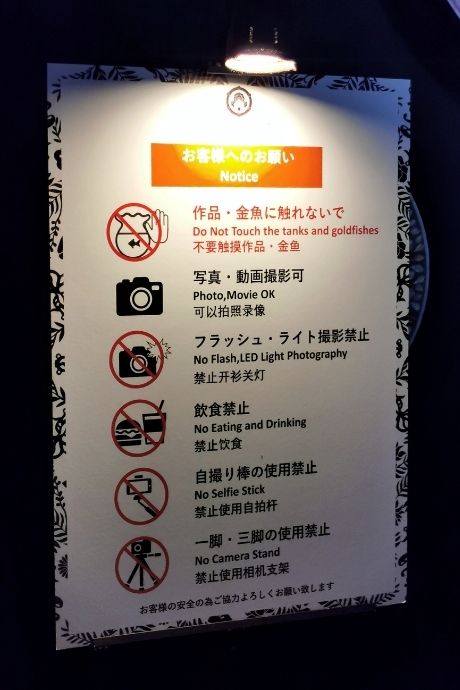
From what I could see, it also looked like the tanks were clean and well-maintained. The fish appeared to be well taken care of, and there was plenty of staff monitoring the exhibitions.
Yet, some of the tanks looked a little small for the size of the goldfish that it contained, and some tanks looked overcrowded. A few of the tanks looked like the size a child would have for their small pet goldfish.
If you are going to visit the Art Aquarium Ginza and any of this is a concern, you should do your research before you go. There are reviews on Google Reviews and TripAdvisor with people giving feedback on these issues. Visitors should go with an open mind and observe for themselves.
Gift Shop at Art Aquarium Ginza
The Gift Shop at the Art Aquarium has many items featuring your standard souvenirs, ranging from items for children to some exquisite traditional Japanese goods.
Some top sellers are large plush goldfish, perfect for young children. There are some t-shirts and tote bags featuring the Art Aquarium Ginza logo. Some art goods are also available, including origami paper crafts to create your own goldfish.
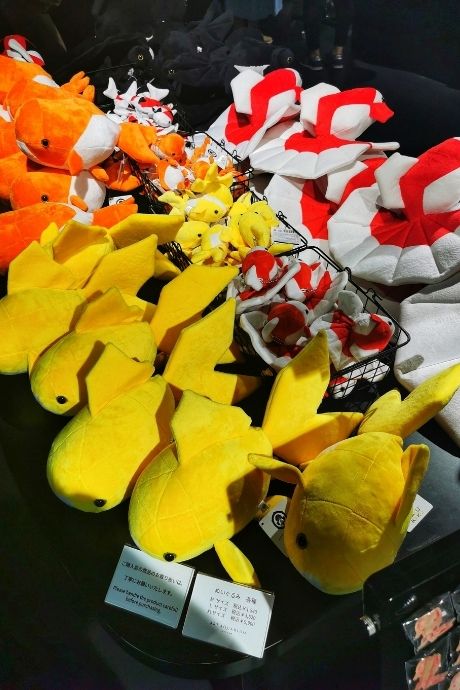
If you enjoy sweets, there are many traditional Japanese sweets and modern candy.
Visitors can buy some of Tsuruya Yoshinobu’s famous Irodori Yokan, a sweetened jelly bean paste bar. Ginza Kikunoya’s Fukiyose comes in a box with various Japanese-style dry sweets, including hard candy, wasanbon sugar, and coated peanuts.
For visitors looking for more typical Japanese souvenirs and gifts, there is a large selection of fans, umbrellas, handkerchiefs, and clothing complete with traditional Japanese printing, patterns, and art designs.
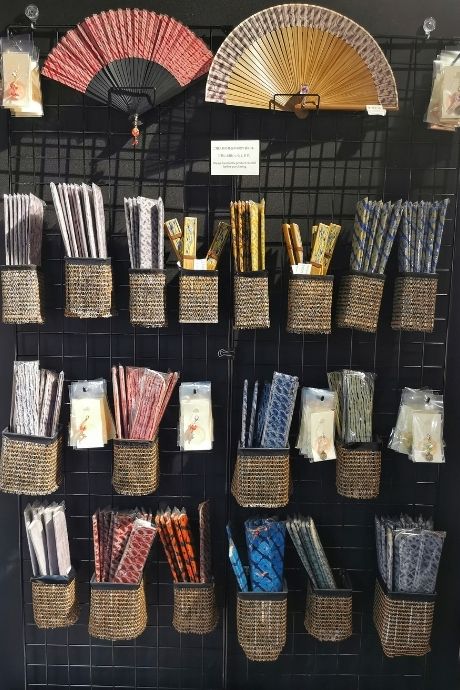
Top Tips for Art Aquarium Ginza
The Art Aquarium Ginza is open seven days a week, so there are plenty of options for planning your visit. But, the Art Aquarium can get very busy on weekends and in the evening.
The best time to visit is early on a weekday. This time will give you the most relaxing experience for exploring. It will also give you the best opportunity to take stunning photos that don’t feature other people in the background.
The Ginza Art Aquarium is on the 8th floor of the Ginza Mitsukoshi building. To find the entrance, you first have to go to the 9th floor, and then you can use the short escalator to take you to the entry on the 8th floor.
The best way to get there is by entering the Mitsukoshi building and riding the elevator to the 9th floor. This point is also where same-day tickets are available to buy.
There is no toilet during the exhibition, so make sure you visit before you enter the museum.
If you are a wheelchair user, use the elevator to go to the 9th floor of Ginza Mitsukoshi and talk to the staff who will give you access.
Unfortunately, you can’t enter the Art Aquarium Museum Ginza with a stroller. There is a stroller storage area on the 9th floor of Ginza Mitsukoshi.
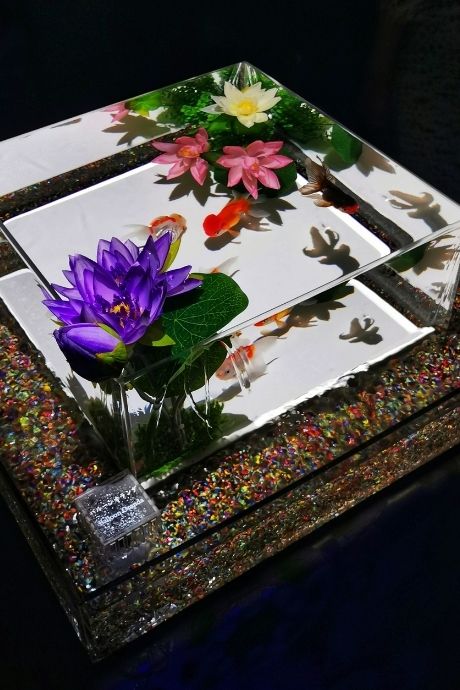
Final Thoughts on Art Aquarium Ginza
The Art Aquarium Museum Ginza is a fun and unique experience. It’s unlike most other art galleries, aquariums, or museums worldwide. It doesn’t take long to work your way around the full Art Aquarium, but the light displays are stunning, and the goldfish are beautiful to admire.
Some great photo and video opportunities can add lots of extra time to your trip if you are trying to capture that perfect moment. The Art Aquarium is one of the most Instagrammable attractions I have ever visited.
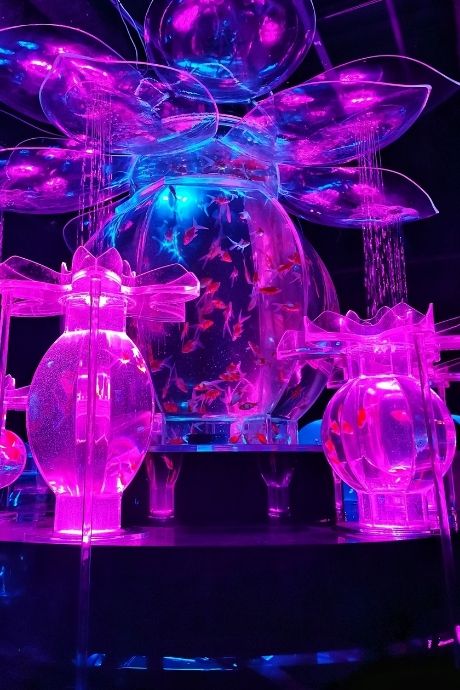
If you visit Japan during the summer, it’s the perfect time to visit the Art Aquarium Museum. The attraction is air-conditioned, so it’s a nice break from the hot and humid Japanese summer.
Some visitors have complained that the Art Aquarium Ginza needs to provide better value for money and that the ticket prices are steep. But if you take your time going around the entire museum checking out all the different species of fish, and you want to capture lots of great photographs and videos, the Art Aquarium is arguably value for money.
- Easily purchase your Art Aquarium Ginza Ticket
- Select your preferred visiting time
- Choose the Klook Tokyo Pass to bundle your Tokyo tickets and get a great discount
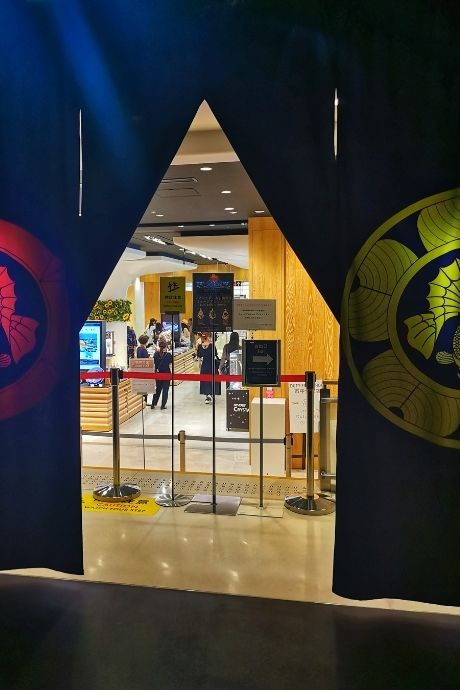
Frequently Asked Questions about Art Aquarium Ginza?
Are you still unsure if you should visit the Art Aquarium? Do you have some last-minute worries before visiting the Ginza Art Aquarium? We’re here to answer some of the most common questions.
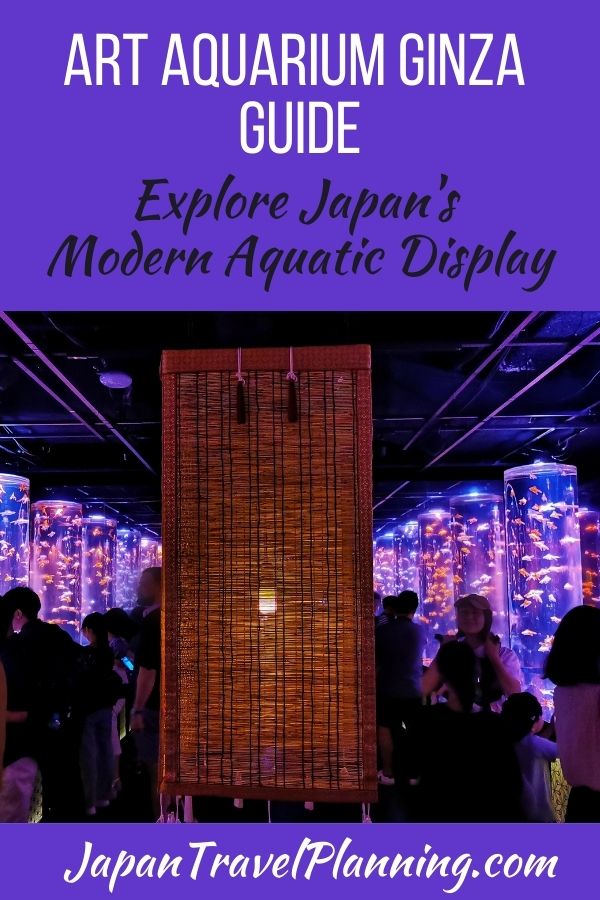
You may also like:
TeamLab Borderless Tokyo: Explore Leading-Edge Digital Art
The Ultimate Tokyo Skytree Guide: Elevate your Tokyo Experience
Wrestle Kingdom Unleashed: The Ultimate Guide for Tourists
TeamLab Planets Tokyo: A Journey Through Digital Art and Sensory Wonders
Sumo Tournaments in Tokyo 2024: Thrills, Spill and Rituals
Unko Museum Tokyo: Explore One of the World’s Quirkiest Museums
Join the Japan Travel Planning Facebook Group or Discord Server
You are also welcome to join our Japan Travel Planning Facebook Group and our Japan Travel Planning Discord Server – they are great resources to enable you to ask questions about your upcoming trip to Japan!
Disclaimer: This article contains affiliate links. If you book after clicking on one of these links then we may receive a small commission at no extra cost to you.




